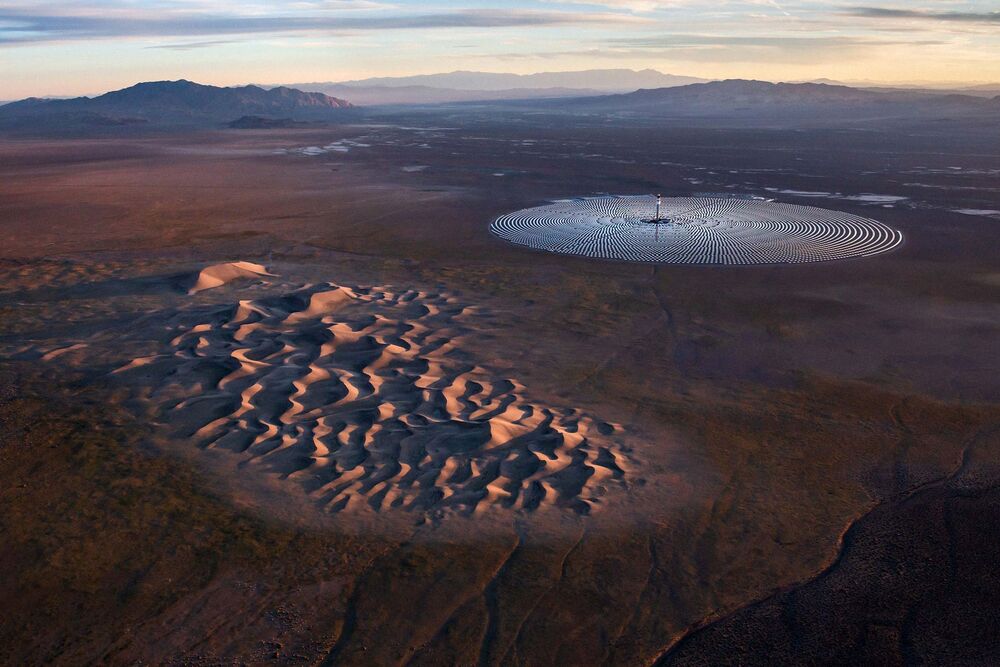A $1 Billion Solar Plant Was Obsolete Before It Ever Went Online
A $1 Billion Solar Plant Was Obsolete Before It Ever Went Online
SolarReserve’s Crescent Dunes received backing
from Citigroup and the Obama Energy Department but couldn’t keep pace
with technological advances.
By
and 
The Crescent Dunes solar plant looks like something out of a sci-fi movie. Ten thousand mirrors form a spiral almost 2 miles wide that winds around a skyscraper rising above the desert between Las Vegas and Reno. The operation soaks up enough heat from the sun’s rays to spin steam turbines and store energy in the form of molten salt.
In 2011 the $1 billion project was to be the biggest solar plant of its kind, and it looked like the future of renewable power. Citigroup Inc. and other financiers invested $140 million with its developer, SolarReserve Inc. Steven Chu, the U.S. Department of Energy secretary at the time, offered the company government loan guarantees, and Harry Reid, then the Senate majority leader and senior senator from Nevada, cleared the way for the company to build on public land. At a Washington celebration of SolarReserve’s public funding, Chief Executive Officer Kevin Smith told the assembled politicians, “We’re proud to be doing our part to win the future.”
SolarReserve may have done its part, but today the company doesn’t rank among the winners. Instead, it’s mired in litigation and accusations of mismanagement at Crescent Dunes, where taxpayers remain on the hook for $737 million in loan guarantees. Late last year, Crescent Dunes lost its only customer, NV Energy Inc., which cited the plant’s lack of reliability. It’s a victim, ironically, of the solar industry’s success over the past decade. The steam generators at Crescent Dunes require custom parts and a staff of dozens to keep things humming and to conduct regular maintenance. By the time the plant opened in 2015, the increased efficiency of cheap solar panels had already surpassed its technology, and today it’s obsolete—the latest panels can pump out power at a fraction of the cost for decades with just an occasional hosing-down.

Solar Reserve’s Crescent Dunes facility.
Source: U.S. Department of Energy
Cost of Solar Technology in $ Per Megawatt-Hour
Under the Trump administration, which has mocked the push for fossil fuel alternatives, it’s easy to imagine Crescent Dunes being used as a talking point if the White House proposes to eliminate federal subsidies for renewable power, says Timothy Fox, a vice president at researcher ClearView Energy Partners LLC. Chris Edwards, the director of tax policy studies at the libertarian Cato Institute, says the feds shouldn’t invest in alternative energy. “There’s a long and growing list of failed government projects,” says Edwards, a former senior economist on the Republican staff of the U.S. Congress Joint Economic Committee. He points to the familiar example of Solyndra LLC, a solar company backed by $535 million in loan guarantees that filed for bankruptcy in 2011.
A buyer might try to bring Crescent Dunes back on line, or its owner could sell it for parts. For now, the plant is mostly a punchline in a part of Nevada that’s seen its share of booms and busts. The nearest town, Tonopah, was the site of a silver rush in the early 1900s. It’s now home to 2,400 people, a motley collection of saloons and casinos, a mining museum, and the Clown Motel, which calls itself “America’s scariest motel” because it’s close to a cemetery and filled with creepy red-nosed tchotchkes. The solar plant’s workers don’t boost business like they used to, says Linda Taylor, the motel’s manager. “It took our money,” she says of the giant mirror matrix up the road. “It’s dead. But real pretty, though. You can see it for miles.”
Comments
Post a Comment